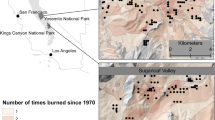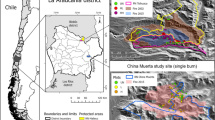Abstract
Disturbances and environmental heterogeneity are two factors thought to influence plant species diversity, but their effects are still poorly understood in many ecosystems. We surveyed understory vegetation and measured tree canopy cover on permanent plots spanning an experimental fire frequency gradient to test fire frequency and tree canopy effects on plant species richness and community heterogeneity within a mosaic of grassland, oak savanna, oak woodland, and forest communities. Species richness was assessed for all vascular plant species and for three plant functional groups: grasses, forbs, and woody plants. Understory species richness and community heterogeneity were maximized at biennial fire frequencies, consistent with predictions of the intermediate disturbance hypothesis. However, overstory tree species richness was highest in unburned units and declined with increasing fire frequency. Maximum species richness was observed in unburned units for woody species, with biennial fires for forbs, and with near-annual fires for grasses. Savannas and woodlands with intermediate and spatially variable tree canopy cover had greater species richness and community heterogeneity than old-field grasslands or closed-canopy forests. Functional group species richness was positively correlated with functional group cover. Our results suggest that annual to biennial fire frequencies prevent shrubs and trees from competitively excluding grasses and prairie forbs, while spatially variable shading from overstory trees reduces grass dominance and provides a wider range of habitat conditions. Hence, high species richness in savannas is due to both high sample point species richness and high community heterogeneity among sample points, which are maintained by intermediate fire frequencies and variable tree canopy cover.





Similar content being viewed by others
References
Axelrod AN, Irving FD (1978) Some effects of prescribed fire at Cedar Creek Natural History Area. J Minnesota Acad Sci 44:9–11
Beckage B, Stout IJ (2000) Effects of repeated burning on species richness in a Florida pine savanna: a test of the intermediate disturbance hypothesis. J Veg Sci 11:113–122
Belsky AJ, Amundson RG, Duxbury JM, Riha SJ, Ali AR, Mwonga SM (1989) The effects of trees on their physical, chemical, and biological environments in a semi-arid savanna in Kenya. J Appl Ecol 26:1005–1024
Bragg TB, Hulbert LC (1976) Woody plant invasion of unburned Kansas bluestem prairie. J Range Manage 29:19–24
Bray JR (1958) The distribution of savanna species in relation to light intensity. Can J Bot 36:671–681
Brewer JS (1998) Patterns of plant species richness in a wet slash-pine (Pinus elliottii) savanna. Bull Torrey Bot Club 125:216–224
Brockway DG, Lewis CE (1997) Long-term effects of dormant-season prescribed fire on plant community diversity, structure, and productivity in a longleaf pine wiregrass ecosystem. Forest Ecol Manage 96:167–183
Collins SL (1992) Fire frequency and community heterogeneity in tallgrass prairie vegetation. Ecology 73:2001–2006
Collins SL, Steinauer EM (1998) Disturbance, diversity, and species interactions in tallgrass prairie. In: Knapp AK, Briggs JM, Hartnett DC, Collins SL (eds) Grassland dynamics: long-term ecological research in tallgrass prairie. Oxford University Press, New York
Collins SL, Glenn SM, Gibson DG (1995) Experimental analysis of intermediate disturbance and initial floristic composition: decoupling cause and effect. Ecology 76:486–492
Connell JH (1978) Diversity in tropical rain forests and coral reefs. Science 199:1302–1310
Curtis JT (1959) Vegetation of Wisconsin; an ordination of plant communities. University of Wisconsin Press, Madison, Wisconsin
Davis MA, Wrage KJ, Reich PB, Tjoelker MG, Schaeffer T, Muermann C (1999) Survival, growth, and photosynthesis of tree seedlings competing with herbaceous vegetation along a water-light-nitrogen gradient. Plant Ecol 145:341–350
Dijkstra FA, Wrage KJ, Hobbie SE, Reich PB (2006) Tree patches show greater N losses but maintain higher soil N availability than grassland patches in a frequently burned oak savanna. Ecosystems 9:441–453
Faber-Langendoen D, Davis MA (1995) Effects of fire frequency on tree canopy cover at Allison Savanna, eastcentral Minnesota, USA. Nat Areas J 15:319–328
Gleason HA (1913) The relation of forest distribution and prairie fires in the middle west. Torreya 13:173–181
Grigal DF, Chamberlain LM, Finney HR, Wroblewski V, Gross ER (1974) Soils of the Cedar Creek Natural History Area. Miscellaneous Report 123, University of Minnesota Agricultural Experiment Station, St. Paul, Minnesota
Grime JP (1973) Control of species density in herbaceous vegetation. J Ecol 1:151–167
Grimm EC (1984) Fire and other factors controlling the Bigwoods vegetation of Minnesota in the mid-nineteenth century. Ecol Monogr 54:291–311
Huston M (1979) A general hypothesis of species diversity. Am Nat 113:81–101
Huston MA (1994) Biological diversity: the coexistence of species on changing landscapes. Cambridge University Press, Cambridge
Inouye RS, Huntly NJ, Tilman D, Tester JR (1987) Pocket gophers (Geomys bursarius), vegetation, and soil nitrogen along a successional sere in east central Minnesota. Oecologia 72:178–184
Irving FD (1970) Field instruction in prescribed burning techniques at the University of Minnesota. Proc Tall Timbers Fire Ecol Conf 10:323–331
Knoop WT, Walker BH (1985) Interactions of woody and herbaceous vegetation in a southern African savanna. J Ecol 73:235–253
Leach MK, Givnish TJ (1999) Gradients in the composition, structure, and diversity of remnant oak savannas in southern Wisconsin. Ecol Monogr 69:353–374
Leitner LA, Dunn CP, Guntenspergen GR, Stearns F, Sharpe DM (1991) Effects of site, landscape features, and fire regime on vegetation patterns in presettlement southern Wisconsin. Landscape Ecol 5:203–217
Lewis CE, Harshbarger TJ (1976) Shrub and herbaceous vegetation after 20 years of prescribed burning in the South Carolina coastal plain. J Range Manage 29:13–18
Littell RC, Milliken GA, Stroup WW, Wolfinger RD (1996) SAS® system for mixed models. SAS Institute, Inc., Cary, North Carolina
Machado J-L, Reich PB (1999) Evaluation of several measures of canopy openness as predictors of photosynthetic photon flux density in deeply shaded conifer-dominated forest understory. Can J For Res 29:1438–1444
Magurran AE (1988) Ecological diversity and its measurement. Princeton University Press, Princeton, New Jersey
McPherson GR (1997) Ecology and management of North American Savannas. University of Arizona Press, Tucson, Arizona
Mehlman DW (1992) Effects of fire on plant community composition of North Florida second growth pineland. Bull Torrey Bot Club 119:376–383
Nuzzo VA (1986) Extent and status of Midwest oak savanna: presettlement and 1985. Nat Areas J 6:3–36
Peterson DW (1998) Fire effects on oak savanna and woodland vegetation in Minnesota. Dissertation. University of Minnesota, Saint Paul, Minnesota
Peterson DW, Reich PB (2001) Prescribed fire in oak savanna: fire frequency effects on stand structure and dynamics. Ecol Appl 11:914–927
Peterson DW, Reich PB, Wrage KJ (2007) Plant functional group responses to fire frequency and tree canopy cover gradients in oak savannas and woodlands. J Veg Sci 18:3–12
Raudenbush SW, Bryk AS (2002) Hierarchical linear models: applications and data analysis methods. Sage Publications, Thousand Oaks, California
Reich PB, Peterson DW, Wedin DA, Wrage K (2001) Fire and vegetation effects on productivity and nitrogen cycling across a forest-grassland continuum. Ecology 82:1703–1719
Ritchie ME, Tilman D, Knops JMH (1998) Herbivore effects on plant and nitrogen dynamics in oak savanna. Ecology 79:165–177
Roxburgh SH, Shea K, Wilson JB (2004) The intermediate disturbance hypothesis: patch dynamics and mechanisms of species coexistence. Ecology 85:359–371
Scholes RJ, Archer SR (1997) Tree-grass interactions in savannas. Ann Rev Ecol Syst 28:517–544
Tester JR (1989) Effects of fire frequency on oak savanna in east-central Minnesota. Bull Torrey Bot Club 116:134–144
Vetaas OR (1992) Micro-site effects of trees and shrubs in dry savannas. J Veg Sci 3:337–344
Waldrop TA, White DL, Jones SM (1992) Fire regimes for pine-grassland communities in the southeastern United States. Forest Ecol Manage 47:195–210
Walker J, Peet RK (1983) Composition and species diversity of pine-wiregrass savannas of the Green Swamp, North Carolina. Vegetatio 55:163–179
Whittaker RH (1975) Communities and ecosystems, 2nd edn. McMillan Publishing Company, New York
Acknowledgements
This study was funded by the Cedar Creek LTER project (NSF grant DEB-9411972, DEB-0080382) and graduate fellowships for D.W. Peterson from the University of Minnesota Graduate School. The USDA Forest Service Pacific Northwest Research Station provided additional support during manuscript preparation. We thank Cindy Buschena, Peter Bakken, Mark Magnuson, Keith Wrage, and many others for their assistance with field surveys and data processing. We also thank L.E. Frelich, M.B. Davis, D.F. Grigal, K.J. Puettmann, D.L. Peterson, D. McKenzie, E. Chaneton, and two anonymous reviewers for helpful manuscript review comments. The use of trade or firm names in this publication is for reader information and does not imply endorsement by the U.S. Department of Agriculture of any product or service.
Author information
Authors and Affiliations
Corresponding author
Rights and permissions
About this article
Cite this article
Peterson, D.W., Reich, P.B. Fire frequency and tree canopy structure influence plant species diversity in a forest-grassland ecotone. Plant Ecol 194, 5–16 (2008). https://doi.org/10.1007/s11258-007-9270-4
Received:
Accepted:
Published:
Issue Date:
DOI: https://doi.org/10.1007/s11258-007-9270-4




